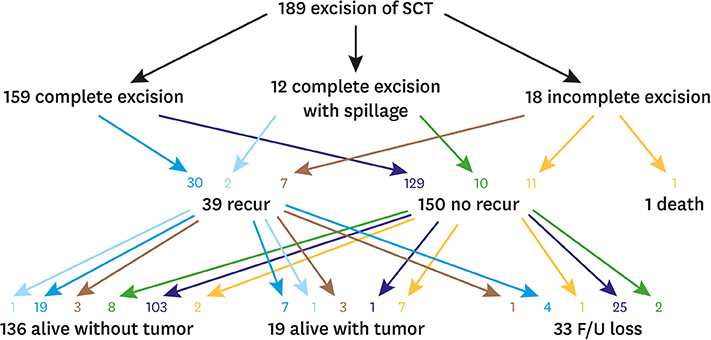Adv Pediatr Surg.
2019 Dec;25(2):35-43. 10.13029/aps.2019.25.2.35.
Sacrococcygeal Teratoma: A Survey by the Korean Association of Pediatric Surgeons in 2018
- Affiliations
-
- 1The Korean Association of Pediatric Surgeons, Seoul, Korea. jtoh@yuhs.ac
- KMID: 2466398
- DOI: http://doi.org/10.13029/aps.2019.25.2.35
Abstract
- PURPOSE
The Korean Association of Pediatric Surgeons (KAPS) performed a nationwide survey on sacrococcygeal teratoma in 2018.
METHODS
The authors reviewed and analyzed the clinical data of patients who had been treated for sacrococcygeal teratoma by KAPS members from 2008 to 2017.
RESULTS
A total of 189 patients from 18 institutes were registered for the study, which was the first national survey of this disease dealing with a large number of patients in Korea. The results were discussed at the 34th annual meeting of KAPS, which was held in Jeonju on June 21-22, 2018.
CONCLUSIONS
We believe that this study could be utilized as a guideline for the treatment of sacrococcygeal teratoma to diminish pediatric surgeons' difficulties in treating this disease and thus lead to better outcomes.
MeSH Terms
Figure
Cited by 1 articles
-
Analysis of Pediatric Surgery Using the National Healthcare Insurance Service Database in Korea: How Many Pediatric Surgeons Do We Need in Korea?
Chaeyoun Oh, Sanghoon Lee, Hye Kyung Chang, Soo Min Ahn, Kyunghee Chae, Sujeong Kim, Sukil Kim, Jeong-Meen Seo
J Korean Med Sci. 2021;36(18):e116. doi: 10.3346/jkms.2021.36.e116.
Reference
-
1. Choi SH, Hwang EH. Clinical analysis of sacrococcygeal teratoma. J Korean Surg Soc. 1985; 29:697–702.2. Gong CS, Kim SC, Kim DY, Kim IK, Namgung JM, Hwang JH, et al. The outcomes of treatment for sacrococcygeal teratoma: the 24-year experiences. J Korean Assoc Pediatr Surg. 2013; 19:81–89.
Article3. Jung SE, Bang HY, Mok WK, Lee SC, Park KW, Kim WK. Sacrococcygeal teratoma in infants and children - Problems according to diagnosis and timing of operation -. J Korean Surg Soc. 1995; 48:127–132.4. Kim JG, Lee J, Moon IS, Lee MD, Park WB, Chun CS, et al. A clinical analysis of sacrococcygeal teratoma. J Korean Surg Soc. 1989; 37:224–231.5. Derikx JP, De Backer A, van de Schoot L, Aronson DC, de Langen ZJ, van den Hoonaard TL, et al. Long-term functional sequelae of sacrococcygeal teratoma: a national study in The Netherlands. J Pediatr Surg. 2007; 42:1122–1126.
Article6. Draper H, Chitayat D, Ein SH, Langer JC. Long-term functional results following resection of neonatal sacrococcygeal teratoma. Pediatr Surg Int. 2009; 25:243–246.
Article7. Ho KO, Soundappan SV, Walker K, Badawi N. Sacrococcygeal teratoma: the 13-year experience of a tertiary paediatric centre. J Paediatr Child Health. 2011; 47:287–291.
Article8. Partridge EA, Canning D, Long C, Peranteau WH, Hedrick HL, Adzick NS, et al. Urologic and anorectal complications of sacrococcygeal teratomas: prenatal and postnatal predictors. J Pediatr Surg. 2014; 49:139–142.
Article9. Sayed HA, Ali AM, Hamza HM, Mourad AF, Eltayeb AA. Sacrococcygeal tumors: clinical characteristics and outcome of pediatric patients treated at South Egypt Cancer Institute. A retrospective analysis. J Pediatr Surg. 2013; 48:1604–1608.
Article10. Usui N, Kitano Y, Sago H, Kanamori Y, Yoneda A, Nakamura T, et al. Outcomes of prenatally diagnosed sacrococcygeal teratomas: the results of a Japanese nationwide survey. J Pediatr Surg. 2012; 47:441–447.
Article



